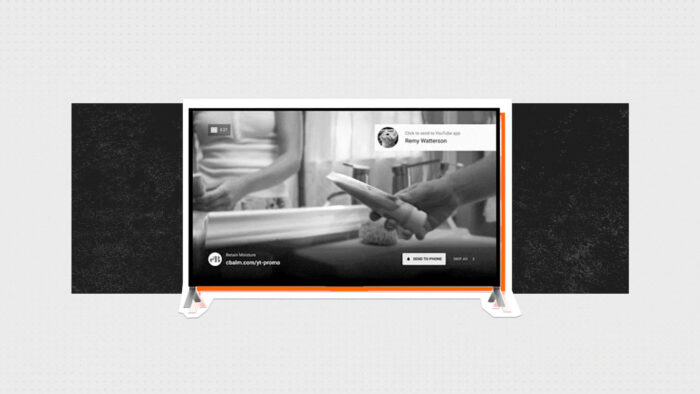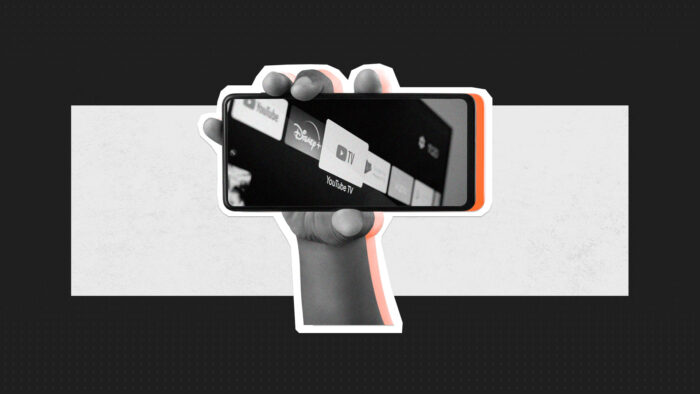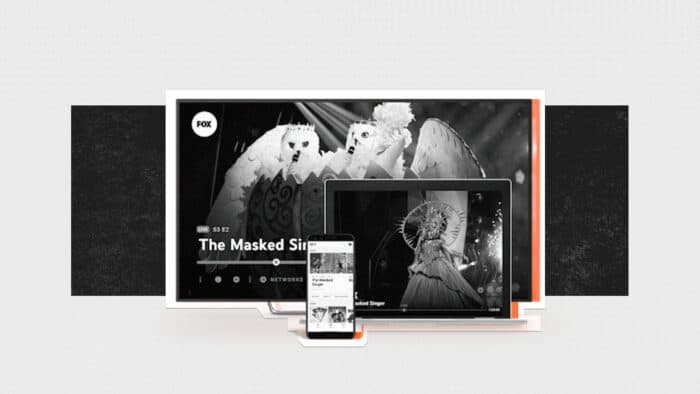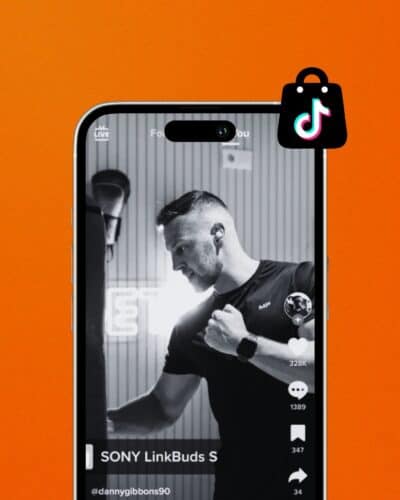Imagine a world where YouTube isn’t confined to your computer screen or mobile phone. Instead, it seamlessly integrates into your everyday life, accompanying you on your TV screens, making its way into your living room. This new era of YouTube, known as YouTube Connected TV (CTV), is reshaping the way we consume video content and revolutionizing the advertising landscape.
We delve into the world of YouTube CTV, exploring its rapid growth, the reasons behind its increasing popularity, and the benefits it offers both viewers and advertisers. We’ll also explore how YouTube is strengthening its CTV offering and how advertisers can make the most of this growing consumption trend.
Contents
YouTube connected TV ad statistics
The benefits of YouTube connected TV
How YouTube is strengthening its CTV offering
How advertisers can make the most of YouTube CTV
How brands are leveraging YouTube CTV
What is YouTube Connected TV?
YouTube accompanies me everywhere, it’s there on my bedside table as I drift off to sleep, and it’s there for me on a long journey helping the hours tick by. In addition to mobile usage, I often find myself watching YouTube content via my TV.
YouTube connected TV refers to the ability to access and watch YouTube on television or other connected devices such as, gaming consoles. Streaming devices and other channels.
In short, a connected TV is a smart TV, appliances that can connect to online content and services. YouTube, along with streaming sites like Netflix, and Amazon Prime has optimized its service to tailor to TV viewership.
YouTube connected TV ad statistics
80% of YouTube CTV viewers in the US watch ad-supported content. (MediaPost)
Over 30 million people streamed YouTube on their TV screens in Great Britain in May 2022, and over 25% of logged-in British YouTube connected TV viewers watched content almost exclusively (90%) on the TV screen. (ThinkWithGoogle)
YouTube ads on TV screens reach 91% of light TV viewers & drive a 10% greater lift in recall than ads on linear TV. (ThinkWithGoogle)
YouTube is the sleeping giant in Connected TV, with around 15% of YouTube ad views occurring on living room screens. (MediaPost)
72% of people said they achieve deeper connections when they watch YouTube with others. (ThinkWithGoogle)
66% of those who watch YouTube on TV with others have created a routine around it. (ThinkWithGoogle)

The Growth of YouTube CTV
YouTube connected TV viewership is growing. According to Nielsen, over 50% of ad-supported streaming watch time happens on YouTube CTV for people ages 18 and over.
At Brandcast 2023, YouTube made connected TV viewership one of the main themes of its presentation. The Google-owned video platform touted its growing audience on TV screens and discussed new ad products that would enable brands to reach those viewers.
YouTube reportedly reaches 150 million monthly users, while data shows that YouTube accounts for 8.1% of all traffic on TV screens, which is more than Netflix (6.9%), Hulu (3.3%), and Prime Video (2.8%).
Why is YouTube Connected TV Viewership Growing?
The draw of Connected TV is the same as what attracts people to digital video in general: control and choice. These variables allow people to create their own personal viewing schedules and routines.
“More and more, viewers are tuning into YouTube on the biggest screens in their home,” said YouTube CEO, Neal Mohan.
“Viewers – especially younger viewers – no longer make a distinction between the kind of content they’re watching. When they turn on the TV, they want everything they love in one place – from their favorite creators, to blockbuster movies, to football. And they can find it all on YouTube.”
Other sources have corroborated YouTube’s claims about the rapid growth of CTV viewership. Recent data from Precise TV shows YouTube’s CTV figures growing at more than double the rate year-on-year. In 2021, mobile phones accounted for 52% of time spent on YouTube, while TV screens accounted for just 25%. In 2022, mobile viewership dropped to 22%, whilst TV screens scaled to 63%.
The growth of YouTube’s CTV offering derives from a shift in viewing habits. George Eliot, an English Victorian-era novelist, once wrote “History, we know, is apt to repeat herself, and to foist very old incidents upon us with only a slight change of costume.” Well, it’s happening – users are learning to love the television again, but change is afoot. TV, now, has access to streaming sites like YouTube, Netflix etc. TV has returned, wearing a slightly different costume.
What do creators think?
Even YouTube creators are noticing the increase of CTV viewing. ThinkWithGoogle spoke to six of the platform’s creators.
Kelsey MacDermaid, of The Sorry Girls, said:
“I know some of our audience likes to watch our videos on the go, but I also know that we have a huge, growing demographic of people that save our videos until they get home from work, or until they really have a break to sit back, put the content on the TV and enjoy it.”
Inventor and breaker of things, Simone Giertz, said:
“it’s fun to think that people might watch my videos on a TV screen. I mean the bigger the screen, the bigger the honor.”

The benefits of YouTube connected TV
YouTube CTV is growing for a reason, here’s some of the benefits for brands looking to diversify its YouTube marketing strategy.
A vast content library
YouTube has an enormous collection of video content on the site, not to mention the additional Shorts and Podcast content. CTV provides viewers with access to explore this extensive library, allowing them to explore and watch a wide variety of videos on the big screen. CTV as a viewing option helps bring high-quality creator productions to life, as well as making it easier for audiences to immerse in long-form content seamlessly.
High-quality viewing experience
YouTube’s TV offering supports high-definition and even 4K resolution, delivering a superior video quality than the likes of mobile and tablet devices. Viewers can enjoy their favorite content with sharper visuals, vibrant colors, and immersive experiences, which helps strengthen the option for watching music videos, movies and other visually captivating content.
Accessibility
Connected TV brings the convenience of YouTube to the living room. Users can access their favorite channels, subscriptions and playlists from the comfort of their sofa, and often with a simple tap of a button, using a smart or Fire TV remote. This eliminates the need for additional smartphones or laptops, and provides a seamless and user-friendly interface optimized for TV viewing.
Ad-supported model
YouTube has been working hard to enable content creators to generate revenue from CTV. This ad-supported model enables creators to monetise their videos, which is a further incentive for more high-quality and engaging content.
CTV acts as a union of linear TV and digital marketing, connecting the best of both worlds into a powerful format. What you get is TV that functions like a digital ad channel – the powerful storytelling medium of TV mixed with precise audience targeting, more accurate reporting, and insightful analytics.
How YouTube is strengthening its CTV offering
While Shorts has been YouTube’s fastest growing content format, Connected TV has been the fastest growing usage category.
It makes sense then that YouTube developed a Shorts experience for home TVs. The offering displays Shorts in a full-screen, interactive format on your larger viewing device. The advantage to displaying Shorts content on the big screen is that more people can tune in at once.
For advertisers, CTV is becoming a household method. With the capacity to run TV-like ad campaigns at a much lower cost, and with much more targeting, it’s no surprise to see a rise in demand.
Last year, YouTube announced that it would be giving advertisers the opportunity to maximize audience reach for specific target markets. This would see brands select from a specific age and gender demographic, and pay only for the ad impressions that reach your target audience, as measured by Nielsen Digital Ad Ratings. This offering enabled a greater level of control for ad campaigns, using Nielsen’s DAR insights to incorporate a more date-led methodology.
Traditional TV is losing its appeal, as consumers get more accustomed to watching whatever they like, when they like. As younger generations spearhead these new consumption trends, the growth of CTV becomes clear, and as it becomes more embedded you should definitely keep it in your radar for media placement.
How advertisers can make the most of YouTube CTV
YouTube announced at Broadcast that it would be offering 30-second unstoppable ads on connected TVs, which allows for a more traditional TV-style commercial experience. That’s not all, YouTube also teased the idea of Pause Ads, pop up ads that appear on TV screens when viewers stop playback within the YouTube app. How can advertisers make the most of the viewing experience, in its current state?
Accounting for everyone
In a study with Nielsen, YouTube found that 26% of the time, multiple 18+ viewers are watching YouTube together on TV, compared to 22% on linear TV. This is referred to as “co-viewing.”
Accounting for co-viewers has been a core part of TV measurement for years. To ensure the same behavior is accounted for with YouTube CTV, co-viewing will be included in Nielsen’s DAR ad reporting in the US. This means advertisers can get an accurate picture of the total audience reached.
YouTube CTV has been well equipped with measurement options to track reach, frequency and total viewer accumulation. This means more accurate reach forecasts and campaign reports with a closer comparison between YouTube and the rest of your linear and connected TV ad purchases.
Reach smarter, at the right frequency
YouTube has a CTV frequency solution that allows for a better viewer experience and more efficient use of your CTV budget.
Display & Video 360 allows advertisers to manage CTV ad frequency across YouTube, YouTube TV and other connected TV apps. This offering helps to lower the risk of ad fatigue for viewers, while adding more reach for the same spend.
CTV works well with an omnichannel strategy
The ability to effortlessly integrate with an existing omnichannel strategy is one of the major advantages of CTV advertising.
According to Digiday and Innovid, most marketers are combining CTV ads with traditional media, such as social media (86%), display advertising (78%), mobile video (77%) and desktop video (67%), or linear TV (54%).
How brands are leveraging YouTube CTV
Connected TV gives advertisers a powerful creative canvas to reach audiences when they are highly engaged, streaming content on the living room screen.
Brands have been exploring the opportunities available with CTV, running experiments to see how effective it could be for their respective audiences. Here’s what they found.
Ruffles
Frito-Lay North America leveraged CTV to engage with some of its core audiences – younger families, millennials, and those living in urban areas. How would increases in watch time via CTV contribute to brand and sales goals?
Running an A/B test with half the media budget allocated to CTV. This resulted in a boost across view rates, ad recall, and sales lift, all achieved without sacrificing CPM or reach.
L’Oréal
For the past several years, L’Oréal has followed the lead of its customers, and ramped up its investment in YouTube year-over-year.
Leaning into CTV, the brand increased its YouTube spend once more, aligning with audience behavior patterns surrounding ad-supported streaming and a boom in CTV viewership.
L’Oréal saw a 6 to 1 return on ad spend on YouTube CTV screens, proving that brands with the right creative can scale to CTV.
“Our consumer is still in the living room, but they’re watching a wider variety of content – content that is more personal, that’s more of the moment. You can ignore that behavior, or you can choose to show up. And we chose to show up,”
said SVP, Head of Media at L’Oreal USA, Shenan Reed.

Concluding thoughts
As YouTube’s CTV viewership continues to grow, outperforming the likes of mobile and laptop usage, advertisers are presented with more unique opportunities in which they can engage audiences. Where the audience goes, the advertisers will follow. YouTube has continued to recognize this by enhancing the CTV infrastructure for both consumers and marketers, constantly evolving the offering to align with behavioral shifts.
YouTube CTV is a great way to connect with Gen Z, as well as Millennials, and perhaps even older generations. As we’ve seen with Ruffles’ activity, YouTube CTV has enabled brands to successfully reach family demographics, which is in alignment with the rise of co-viewing on the platform. Not only do advertisers now have access to a series of demographics, like with linear TV, they can also reach multiple audiences with the same placements thanks to the resurgence of living room viewing.
Traditional TV has lost its appeal. YouTube CTV is all that and more, combining traditional viewing habits with the possibilities of a social media and digital marketing platform rolled into one.
Are you a brand looking to diversify your YouTube marketing strategy? Explore the benefits, optimize your ad campaigns, and stay ahead of the competition. Get in touch today and elevate your marketing strategy with YouTube!





